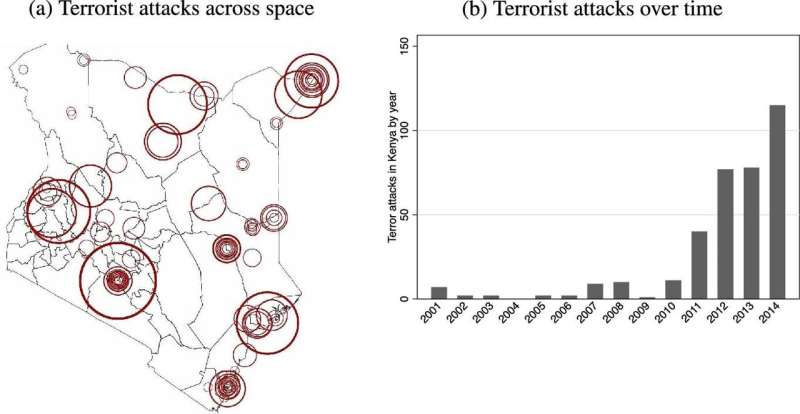Terrorist attacks in Kenya. The figure reports the number of casualties and attacks in Kenya. Panel (a) shows the geographic distribution of attacks occurring during the years 2001–2014, with radii indicating the number of casualties per attack. Panel (b) shows the increase in the number of attacks over time. Source: GTD; own calculations. Credit: Journal of the European Economic Association (2022). DOI: 10.1093/jeea/jvac054
Media coverage of terrorist attacks significantly raises fear amongst families and leads to children being kept out of schools in Kenya, new research reveals.
Kenyan families with access to radio, mobile phones or TV are found to be significantly more afraid of terrorism and are less likely to send their children to school.
The new study by Lancaster University Management School and Bocconi University in Italy, published in the Journal of the European Economic Association, finds that Kenyan parents with access to mass media believe that the risk of dying in a terrorist attack is 12 times larger than actual rates. As a result, these parents are more likely to keep their children out of school.
Comparing school enrollment rates over time, the study finds that the negative effect of terrorist attacks on school enrollment is twice as large for children with access to mass media, than for children without.
"Terrorism differs from other types of violence such as war or gun crime, in that it results in relatively low casualty numbers and causes minimal damage to infrastructure," co-author Dr. Marco Alfano from Lancaster University Management School explains. "Nevertheless, terrorism can severely affect economies by heightening fears."
"Our data shows that while al-Shabaab rarely targets educational institutions, their attacks decrease school enrollments substantially in Kenya. Crucially, results show that this negative effect doubles in size if parents have access to mass media, such as the radio, for instance. This suggests that media coverage plays a crucial role in stoking fears and keeping children out of school."
Researchers say that families without media access react predominantly to attacks close to their homes, whereas families with access to media keep their children out of school in response to terrorist attacks happening more than 100 km away.
"This loss of education is significant," co-author Dr. Joseph-Simon Görlach from Bocconi University adds. "The decline in school enrollment leads to decreased earnings later on in life when compared to peers in areas with no terrorist attacks. We find media coverage of terrorist events reduces children's earnings in later life by around 25% of a year's income."
The study saw researchers use geo-coded data on wireless signal strength for radio and television and the staggered rollout of mobile phone coverage to study the effect of exposure to mass media from both a geographical and chronological point of view.
They analyzed the geographical concentration of terrorist attacks using precise information from the Global Terrorism Database and, by studying the chronology of attacks over a long period of time, the authors were able to identify variation and trends in the data.
They then used three independent data sources on school attendance and enrollment in Kenya (the Hunger Safety Net Program and the 2009 and 2014 rounds of country-wide Demographic Health Survey, and county level administrative data) along with Afrobarometer for data capturing public attitudes as part of the study.
In assessing trends from these multiple sources, then overlaying the geographical coordinates of respondents' homes in relation to radio signal coverage and mobile network data, the authors were able to show that each terrorist attack decreases school enrollment by around 0.4-0.5 percentage points for households without media access. For households with wireless signal coverage for radio, telephone or television, the effect is a statistically significant 0.5-0.7 percentage points stronger.
"This study should be useful for Kenyan Government and other similar nations that are pouring incredible resource and finances into incentives to boost school attendance and the quality of education for young people," Dr. Alfano continues.
"Our results show that access to media has significantly increased fear of terrorism in the country and this has a significant ripple-effect which is impacting younger generations who are being kept out of school and suffer financially later in life."
"Our results could serve as a caution against sensationalism and in favor of moderate and fact-oriented reporting of terrorist events. Providing children with fast, reliable and secure transport to school may also mitigate some of these negative effects. These changes would likely make a considerable difference to children's education and Kenya's long-term growth and development."
The paper is published in the Journal of the European Economic Association.
More information: Marco Alfano et al, Terrorism, media coverage and education: Evidence from al-Shabaab attacks in Kenya, Journal of the European Economic Association (2022). DOI: 10.1093/jeea/jvac054
Provided by Lancaster University























